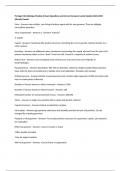Tentamen (uitwerkingen)
Portage Microbiology Module 6 Exam Questions and Correct Answers Latest Update Already Passed
- Vak
- Instelling
Portage Microbiology Module 6 Exam Questions and Correct Answers Latest Update Already Passed Virus - Answers non-cellular, non-living infectious agent with its own genome. They are obligate intracellular parasites. Virus components - Answers 1. Genomic material 2. Capsid Capsid - Answers mem...
[Meer zien]




